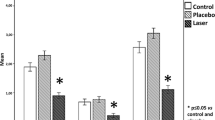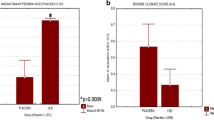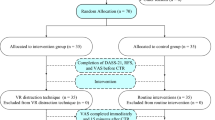Abstract
This study aimed to analyze the effects of light-emitting diode (LED) therapy on sternotomy pain and healing in patients who underwent coronary artery bypass grafting (CABG). The patients were followed for 6 months after the surgery to determine their dehiscence. This study was conducted with 90 volunteers who electively submitted to CABG. The volunteers were randomly allocated into three different groups of equal size: LED (λ of 640 ± 20 nm and spatial average energy fluency of 1.2 J/cm2 during hospitalization), placebo, or control. The outcomes assessed were pain when coughing by a visual analog scale (VAS) and the McGill questionnaire and sternotomy healing by clinical assessment and photographical register end interpretation. The LED group had better pain reduction, as indicated by both the VAS and the McGill questionnaire (number of words chosen and pain index) (p ≤ 0.05), on days 6 and 8 after hospital discharge compared to the placebo and control groups. One month after surgery, almost no individual mentioned pain when coughing. Three researchers blindly analyzed the incision photographs to determine hyperemia and wound closure, and they found that the LED group had both less hyperemia and less incision bleeding or dehiscence. The LED therapy (640 nm) had an analgesic effect on the sternotomies of patients who underwent CABG, increasing their incision healing and preventing dehiscence.



Similar content being viewed by others
References
Piegas LS, Bittar OJNV, Haddad N (2009) Review article myocardial revascularization surgery (MRS). Results from National Health System (SUS). Arq Bras Cardiol 93:513–518
Ghali W a, Quan H, Brant R (1998) Coronary artery bypass grafting in Canada: hospital mortality rates, 1992–1995. CMAJ 159:926–930
Bukkapatnam RN, Yeo KK, Li Z, Amsterdam E a (2010) Operative mortality in women and men undergoing coronary artery bypass grafting (from the California Coronary Artery Bypass Grafting Outcomes Reporting Program). Am J Cardiol 105:339–342. doi:10.1016/j.amjcard.2009.09.035
El Oakley RM, Wright JE (1996) Postoperative mediastinitis: classification and management. Ann Thorac Surg 61:1030–1036. doi:10.1016/0003-4975(95)01035-1
Xavier M, David DR, de Souza RA et al (2010) Anti-inflammatory effects of low-level light emitting diode therapy on Achilles tendinitis in rats. Lasers Surg Med 42:553–558. doi:10.1002/lsm.20896
Casalechi HL, Nicolau R a, Casalechi VL et al (2009) The effects of low-level light emitting diode on the repair process of Achilles tendon therapy in rats. Lasers Med Sci 24:659–665. doi:10.1007/s10103-008-0607-6
Oliveira RA, Matos AF, Regina N et al (2013) Low-intensity laser therapy and led (light emitting diode) therapy in mechanical resistance of Rattus norvegicus chest incision with implant of steel wire for sternal suture. Braz J Biomed Eng 29:166–174. doi:10.4322/rbeb.2013.016
Whelan HT, Buchmann EV, Dhokalia A et al (2003) Effect of NASA light-emitting diode irradiation on molecular changes for wound healing in diabetic mice. J Clin Laser Med Surg 21:67–74. doi:10.1089/104454703765035484
Dall Agnol MA, Nicolau RA, de Lima CJ, Munin E (2009) Comparative analysis of coherent light action (laser) versus non-coherent light (light-emitting diode) for tissue repair in diabetic rats. Lasers Med Sci 24:909–916. doi:10.1007/s10103-009-0648-5
de Morais NCR, Barbosa AM, Vale ML et al (2010) Anti-inflammatory effect of low-level laser and light-emitting diode in zymosan-induced arthritis. Photomed Laser Surg 28:227–232
Bastos JLN, Lizarelli RFZ, Parizotto N a (2009) Comparative study of laser and LED systems of low intensity applied to tendon healing. Laser Phys 19:1925–1931. doi:10.1134/S1054660X09170022
Melzack R (1975) The McGill pain questionnaire: major properties and score methods. Pain 1:277–299
Menezes Costa LDC, Maher CG, McAuley JH et al (2011) The Brazilian-Portuguese versions of the McGill Pain Questionnaire were reproducible, valid, and responsive in patients with musculoskeletal pain. J Clin Epidemiol 64:903–912. doi:10.1016/j.jclinepi.2010.12.009
Bassalobre J, Borges C, Leandra D et al (2006) Pain intensity and postoperative functional assessment after heart surgery. Braz J Cardiovasc Surg 21:393–402
Piva JAAC, Silva VS, Abreu EMC, Nicolau RA (2011) Effect of low-level laser therapy on the initial stages of. Braz An Dermatol 86:947–954
Sakurai Y, Yamaguchi M, Abiko Y (2000) Inhibitory effect of low-level laser irradiation on LPS-stimulated prostaglandin E2 production and cyclooxygenase-2 in human gingival fibroblasts. Eur J Oral Sci 108:29–34
Nomura K, Yamaguchi M, Abiko Y (2001) Inhibition of interleukin-1β production and gene expression in human gingival fibroblasts by low-energy laser irradiation. Lasers Med Sci 16:218–223. doi:10.1007/PL00011358
Bjordal JM, Johnson MI, Iversen V et al (2006) Low-level laser therapy in acute pain: a systematic review of possible mechanisms of action and clinical effects in randomized placebo-controlled trials. Photomed Laser Surg 24:158–168. doi:10.1089/pho.2006.24.158
Dargaville TR, Farrugia BL, Broadbent J a et al (2013) Sensors and imaging for wound healing: a review. Biosens Bioelectron 41:30–42. doi:10.1016/j.bios.2012.09.029
Terris DD, Woo C, Jarczok MN, Ho CH (2011) Comparison of in-person and digital photograph assessment of stage III and IV pressure ulcers among veterans with spinal cord injuries. J Rehabil Res Dev 48:215. doi:10.1682/JRRD.2010.03.0036
Olbrecht V a, Barreiro CJ, Bonde PN et al (2006) Clinical outcomes of noninfectious sternal dehiscence after median sternotomy. Ann Thorac Surg 82:902–907. doi:10.1016/j.athoracsur.2006.04.058
Tuyl LJ, Mackney JH, Johnston CL (2012) Management of sternal precautions following median sternotomy by physical therapists in Australia: a web-based survey. Phys Ther 92:83–97. doi:10.2522/ptj.20100373
Huang P-J, Huang Y-C, Su M-F et al (2007) In vitro observations on the influence of copper peptide aids for the LED photoirradiation of fibroblast collagen synthesis. Photomed Laser Surg 25:183–190. doi:10.1089/pho.2007.2062
Caetano KS, Frade MAC, Minatel DG et al (2009) Phototherapy improves healing of chronic venous ulcers. Photomed Laser Surg 27:111–118. doi:10.1089/pho.2008.2398
De Sousa APC, Santos JN, Dos Reis J a et al (2010) Effect of LED phototherapy of three distinct wavelengths on fibroblasts on wound healing: a histological study in a rodent model. Photomed Laser Surg 28:547–552. doi:10.1089/pho.2009.2605
Holder MJ, Milward MR, Palin WM et al (2012) Effects of red light-emitting diode irradiation on dental pulp cells. J Dent Res 91:961–966. doi:10.1177/0022034512456040
Neves SMV, Nicolau RA, Filho ALMM et al (2013) Digital photogrammetry and histomorphometric assessment of the effect of non-coherent light (light-emitting diode) therapy (λ640 ± 20 nm) on the repair of third-degree burns in rats. Lasers Med Sci. doi:10.1007/s10103-013-1312-7
Author information
Authors and Affiliations
Corresponding author
Rights and permissions
About this article
Cite this article
de Oliveira, R.A., Fernandes, G.A., Lima, A.C.G. et al. The effects of LED emissions on sternotomy incision repair after myocardial revascularization: a randomized double-blind study with follow-up. Lasers Med Sci 29, 1195–1202 (2014). https://doi.org/10.1007/s10103-013-1503-2
Received:
Accepted:
Published:
Issue Date:
DOI: https://doi.org/10.1007/s10103-013-1503-2




